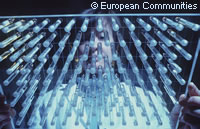Research finds gene at root of birth defects
Research carried out in the UK and supported by the European Union among others has identified a gene which causes spina bifida and other birth defects. A team of scientists and researchers led by Dr Philip Stanier at Imperial College. London, and by Professor Andrew Copp at University College, also in London, made the discovery using mice to replicate human test conditions. 'We have identified the gene that is mutated in the loop-tail strain of mice. These mice develop the severe form of spina bifida closely resembling that seen in humans,' said Dr Stanier. Spina bifida, one of the most common birth defects, occurs in early pregnancy when the neural cord, the part of the foetus that forms the brain and the spinal cord, fails to close properly. Having narrowed down to 12 genes those that were suspected of causing this to happen, the teams carried out tests which revealed that 11 of them were involved in neural cord formation. A mutation in the twelfth newly identified gene, Lpp1, was discovered, leading to the team's findings. 'Our identification of the loop-tail gene is a key finding which will aid in understanding the developmental pathway that regulates neural tube closure. The long term aim of our research is to develop new methods for preventing spina bifida by treating the embryo as it develops during pregnancy,' said Professor Copp. Spina bifida affects one in every 1,000 pregnancies and its effects can range from stillbirth, in the most severe cases, to paralysis and incontinence.



